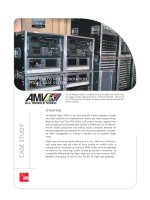AMV BUILDS NEXT GENERATION FLIGHT CASE SYSTEM
Bạn đang xem bản rút gọn của tài liệu. Xem và tải ngay bản đầy đủ của tài liệu tại đây (283.37 KB, 4 trang )
SITUATION
All Mobile Video (AMV) is an internationally known provider of audio
and video solutions for entertainment, sports and news programming.
Based in New York City, AMV offers a full array of services ranging from
sound stages and post-production facilities in Manhattan to 20 state-of-
the-art mobile production and editing trucks. Increased demand for
remote programming, especially for out-of-country operations, prompt-
ed AMV management to re-enter a familiar line of business—flight
cases.
Flight cases, of course, were nothing new. In fact, AMV was in that busi-
ness some years ago but chose to focus instead on mobile trucks, a
strategy which has proven successful as AMV mobile units are deployed
on many of the most high profile remote productions worldwide. To
successfully differentiate the flight cases and earn new business, AMV
decided it was going to have to raise the bar for flight case capability.
AMV BUILDS NEXT GENERATION
FLIGHT CASE SYSTEM
CASE STUDY
The All Mobile Matrix is a mobile production flight case system that
can support large-scale productions in both HD and SD. Shown are
four VTR racks with HD decks as well as router panels and dual flat
screen monitors.
The new flight case system—dubbed the All
Mobile Matrix—was designed with advanced
capabilities and on a scale not available in the
marketplace. The All Mobile Matrix would
approximate the functions of a full 53-foot mobile
unit including support for up to 16 cameras, a full
80 input by 48 output switch, and both high
definition and standard definition capable.
Beyond advanced production and editing
capabilities, AMV established other criteria for the
All Mobile Matrix. Given that the new flight cases
would be subjected to repeated, rough handling
and widely varying environmental conditions,
components must be both rugged and highly
reliable. In addition, the flight cases would have to
be highly flexible for not only maintenance and
troubleshooting, but also for accommodating the
varied wiring configurations and production
requirements of different venues and engineers.
SELECTION THROUGH
DISSECTION—CHOOSING AUDIO
AND VIDEO PATCH BAYS
An important part of the All Mobile Matrix design
was flexibility through use of audio and video
patch bays. Granted, hardwired components may
withstand the bumps and grinds of being carried
by airlines across the world or by donkeys up a
mountain better than patch bays. Yet AMV valued
the ability to quickly and easily reconfigure and
troubleshoot using patch bays. Still, the challenge
was to find highly reliable and rugged patch bays.
Not choosing to believe every promise in
marketing brochures, the AMV team purchased
audio and video jacks and shelf assemblies from
several manufacturers and dissected each to the
subcomponent level.
The engineers were surprised when one vendor’s
patch bay was actually wired incorrectly. The
engineers were not surprised, however, to find
that the ADC audio and video products were
designed for long-term use and exceptional signal
response.
Keeping most cases under 70 pounds was
important, making the weight of each component
a critical factor. While all tested products featured
fairly comparable weight, the ADC patch products
clearly stood out on features and performance.
CASE STUDY
Lee Blanco, director of operations for AMV, works in the engi-
neering section of the All Mobile Matrix, patching video
through ADC’s MVJ-3 video patch bays.
”Weight is always a concern with flypacks,“
said Lee Blanco, Director of Operations for AMV
and the chief architect of the All Mobile Matrix.
”But weight takes second place to performance
and that is why we chose ADC,“ he said.
During the evaluation process, Blanco and his
team found that lighter sometimes also meant
flimsy. “These cases need to take punishment.
I had the impression (with other bays) that if I had
to mount several Edacs on the back and allow
the case to bounce down the road, I would
question the unit’s ability to stay together. ADC
has the most rugged patching products available,”
said Blanco.
AUDIO PATCHING FOR THE LONG
HAUL
The evaluation pointed to ADC’s Pro Patch®
Programmable Bantam for audio patching in the
All Mobile Matrix. From a construction standpoint,
use of WECO platinum/gold crossbar contacts,
instead of non-crossbar type springs, offered a
superior design. Combined with mechanical
wiping action and high contact force, the Pro
Patch would deliver steady performance even as
dust and other residues cling to contacts. Both
modular jacks and chassis pass MIL-202
environmental testing for moisture, heat, corrosion
and vibration, making them a good fit for flight
cases.
“Our experience with ADC says these (Pro Patch)
jacks will have zero problems for the first five years.
By year seven, we might expect one or two bad
jacks and by year 10, just a few more—well within
spec,” said Paul Brinkman, Senior Field Engineer
with AMV. “We have occasionally been lured into
buying other jacks but always end up switching
back to ADC. For the long run, it pays to get the
right products,” he said.
Content that the Pro Patch would provide
consistent, long-term performance, AMV
engineers were then won-over by the all front,
individual jack access of the Pro Patch series. Each
bantam jack card slides out of the panel for access
to a seven-position DIP switch for configuring
circuit normals and grounds on individual circuits.
Changes can be made on individual circuits
without removing a panel from the rack or
affecting other circuits and without using pins and
jumpers.
CASE STUDY
ADC Pro Patch series audio patching products are used in the
communications section of the All Mobile Matrix.
“We have occasionally been lured
into buying other jacks but always
end up switching back to ADC.
For the long run, it pays to get the
right products.”
– Paul Brinkman,
Senior Field Engineer with AMV
“It was obvious which audio bay to use. The
design of the (ADC) audio patch bay gives us
complete control to instantly swap jack points. You
can’t do this with other systems,” said Brinkman.
“Anything can happen in the field. The case could
be in a rain forest today and in a desert next
month. Knowing you can swap jacks in and out in
seconds versus an hour adds tremendous value to
the All Mobile Matrix,” he said.
SEALED VIDEO JACKS
FOR PEACE OF MIND
As video jacks and panels were subjected to the
scrutiny of the AMV staff, ADC’s MVJ-3 Midsize
Super Video Jack surfaced as the top pick for video
patching. First of all, the jack performed well on
the bench, showing its capability to handle high
bandwidth with acceptable return loss and
minimal insertion loss, making it suitable for high
definition productions.
To AMV engineers, the design of the MVJ-3
revealed nothing but durability. Dust-sealed,
gold-plated/beryllium copper cantilever switching
springs, with only a fraction of the moving parts as
contained in jacks with micro-switch designs, was
a design that the AMV staff thought could offer
increased reliability and performance consistency
over the life of the jack.
Yet there were other design details—often
minor—that helped make the MVJ-3 the obvious
choice. RFI suppression through use of a two-piece
center conductor impedes unwanted signal flow,
improving frequency response and return loss
characteristics. Other elements such as solder free
construction and a grounding clip that makes
contact with the coax plug in seven points
contributed to the conclusion by AMV that for
video patching in the rough and variable world of
flight cases the ADC video jack was the correct
choice.
“All components of the flight case need to take
punishment and still perform. ADC has
engineered-in the right set of features to make
this (MVJ-3) jack the most durable on the market
today,” said Blanco.
THE KEY INGREDIENT FOR
SUCCESS—FLEXIBILITY
As a next generation flight case system, the All
Mobile Matrix was designed to be highly flexible.
It is a hybrid unit, supporting high definition,
standard definition or any mix for the same show.
For customers who need just a few additional
cameras, there is the flexibility of adding just
several cases from the All Mobile Matrix to provide
adjunct capability in support of a mobile unit.
Also, with wiring and set-up different for every
venue and producer, use of ADC audio and video
patching adds critical flexibility that allows
extensive reconfiguration to support the specific
needs of each show. For AMV customers, all of this
flexibility translates into savings of time and
money—without short cutting production.
“We have built-in the capabilities to meet the full
production requirements for any event worldwide
in a compact, easy to use system,” said Blanco.
“With any flypack, you have to be concerned
about cases being abused and broken. I don’t
believe there was a better choice of patching gear
for what we are doing. ADC has helped make this
flypack project a success,” said Blanco.
ADC Telecommunications, Inc., P.O. Box 1101, Minneapolis, Minnesota USA 55440-1101
Specifications published here are current as of the date of publication of this document. Because we are continuously
improving our products, ADC reserves the right to change specifications without prior notice. At any time, you
may verify product specifications by contacting our headquarters office in Minneapolis. ADC Telecommunications,
Inc. views its patent portfolio as an important corporate asset and vigorously enforces its patents. Products or
features contained herein may be covered by one or more U.S. or foreign patents. An Equal Opportunity Employer
1297803 12/04 Original © 2004 ADC Telecommunications, Inc. All Rights Reserved
Web Site: www.adc.com
From North America, Call Toll Free: 1-800-366-3891 • Outside of North America: +1-952-938-8080
Fax: +1-952-917-3237 • For a listing of ADC’s global sales office locations, please refer to our web site.
CASE STUDY









